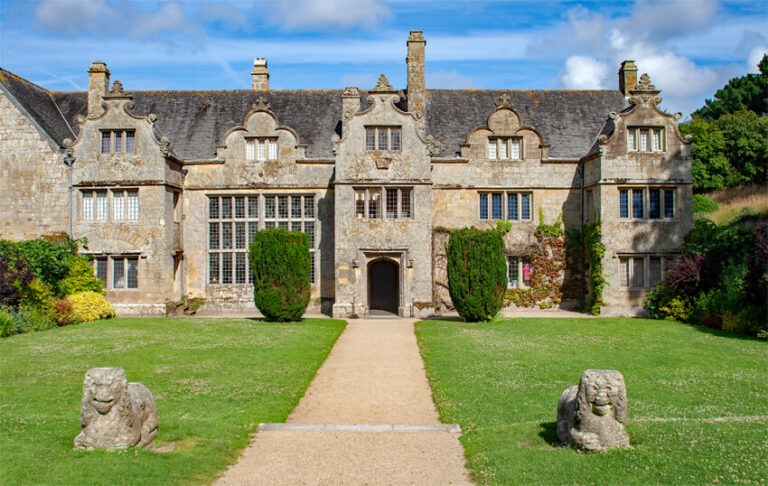The Best Elizabethan Houses in England
Elizabethan architecture refers to the architectural style that was popular during the reign of Queen Elizabeth I. Elizabeth reigned from 1558 to 1603 and while she didn’t build any new royal palaces, the gentry in England built grand houses to show off their wealth and importance. These prodigy houses were built around a “Great Hall” with wings for more private spaces. This style of architecture is part of the English Renaissance movement.
Houses that were built during the Elizabethan period were often designed in an E-shape to honor the reigning Queen. Other features are ornate designs, wood paneling, and large glass windows.
Many Elizabethan houses in England have survived and can be visited. The most famous Elizabethan house is Hardwick Hall which was built by the richest woman in England (after the Queen). But you can find more Elizabethan houses from Northern England to all the way south in Cornwall. This article shows the Elizabethan manor houses in England that you can visit.
Elizabethan Houses in Northern England
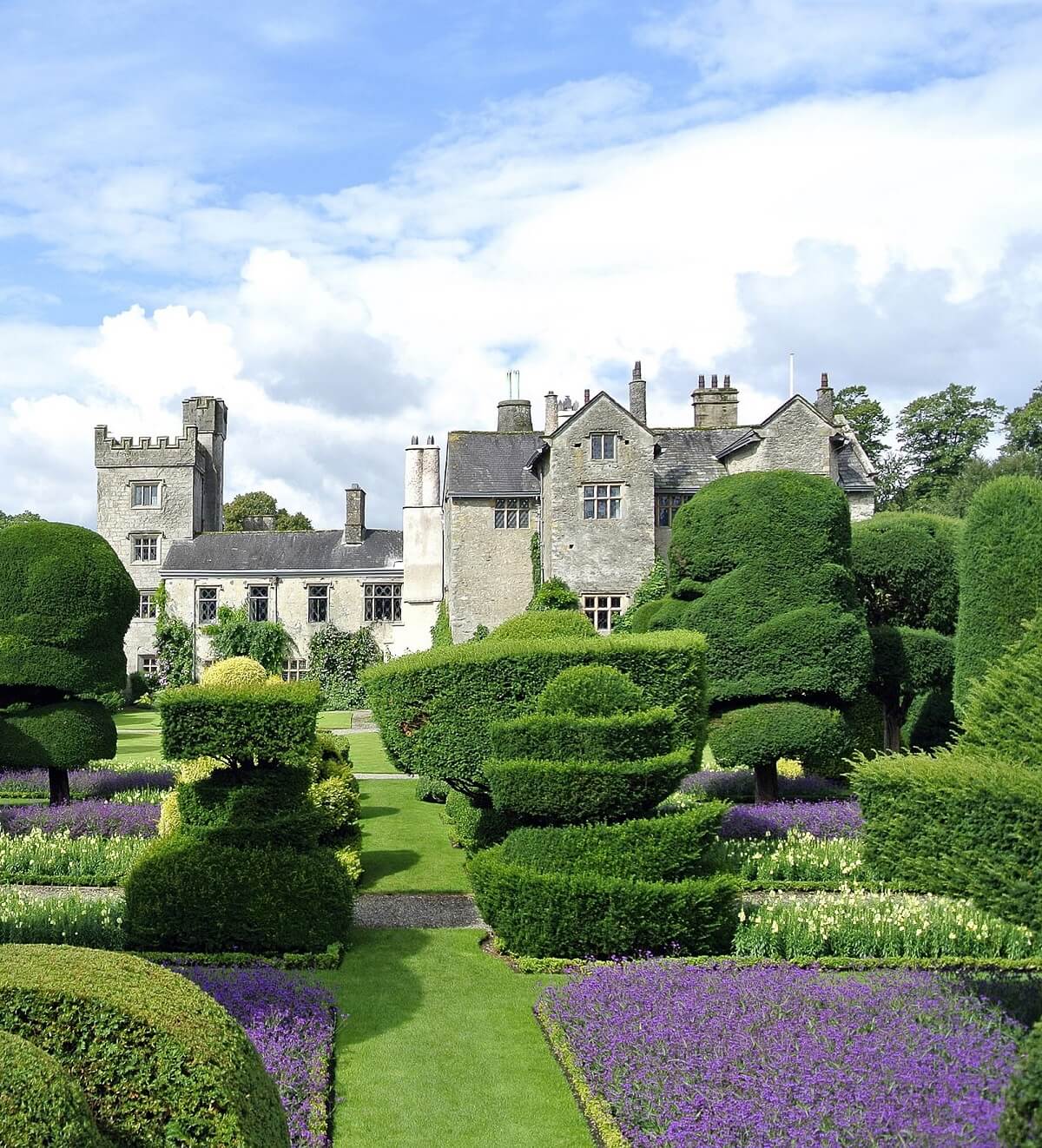
Levens Hall
Originally built as a Pele Tower in the 13th century, the tower was transformed into a stunning Elizabethan country house by the Bellingham family (who would eventually gamble it away in a game of cards). The Bellingham decorated the house with fine paneling and plasterwork that can still be seen to this day.
Every generation left a mark on this historic home that is located near the Lake District National Park. Marvel at the interiors with its oak paneling, ornate plasterwork, a grand collections of furniture, paintings, and clocks. You can also wander the garden, which is largely unchanged since the 17th century. The gardens include the world’s oldest topiary gardens. Visit the website for opening times.

Burton Agnes Hall
Burton Agnes Hall is an Elizabethan country house in Yorkshire that has been owned by the same family since its construction in 1598. Burton Agnes Hall is still used as a family home and it’s currently the home of Simon Cunliffe-Lister and his family.
That Burton Agnes Hall is still a family home combined with the fact that the house hasn’t been changed much over the centuries make this English stately home unique. The architect of the hall is Robert Smythson, Master Mason to Queen Elizabeth I. He also designed other famous Elizabethan houses like Hardwick, Wollaton, and Longleat which you will see later on in this article.
The house and gardens are open to visitors. The house also hosts a selection of events. You can read more on the website.

Burton Constable Hall
In the 1560s, Sir John Constable built the Elizabethan prodigy house, Burton Constable Hall, incorporating elements of an earlier medieval house. For more than 700 years, the hall has been the family home of the Constable family.
The interiors of Burton Constable Hall mainly date from the 18th- and 19th centuries. The thirty rooms that are open to the public are filled with beautiful furniture, art, and other objects from the Constable family collection. Notable rooms are the Long Gallery and the Chinese Room that was inspired by the Brighton Pavilion.
The grounds are landscaped by Capability Brown. The hall is especially nice for families as it has an indoor and outdoor playground, a Wildlife Sculpture Trail, a whale skeleton, and more family fun.
The house and grounds are open to visitors. Visit the website for opening times.
Oakwell Hall
Oakwell Hall is a 16th century Elizabethan manor house in West Yorkshire that was built for John Batt. The interiors of the hall have been renovated and furnished as a family home in the 1690s.
The building is mainly unchanged since its construction more than four hundred years ago. You can tour beautiful period rooms that show great insight into a post-English Civil household. The house is set in 110 acres of parkland and gardens with a natural trail, picnic site, and a playground for children.
The house and grounds are now owned by Kirklees Council and is open to visitors. Visit the website for opening times.
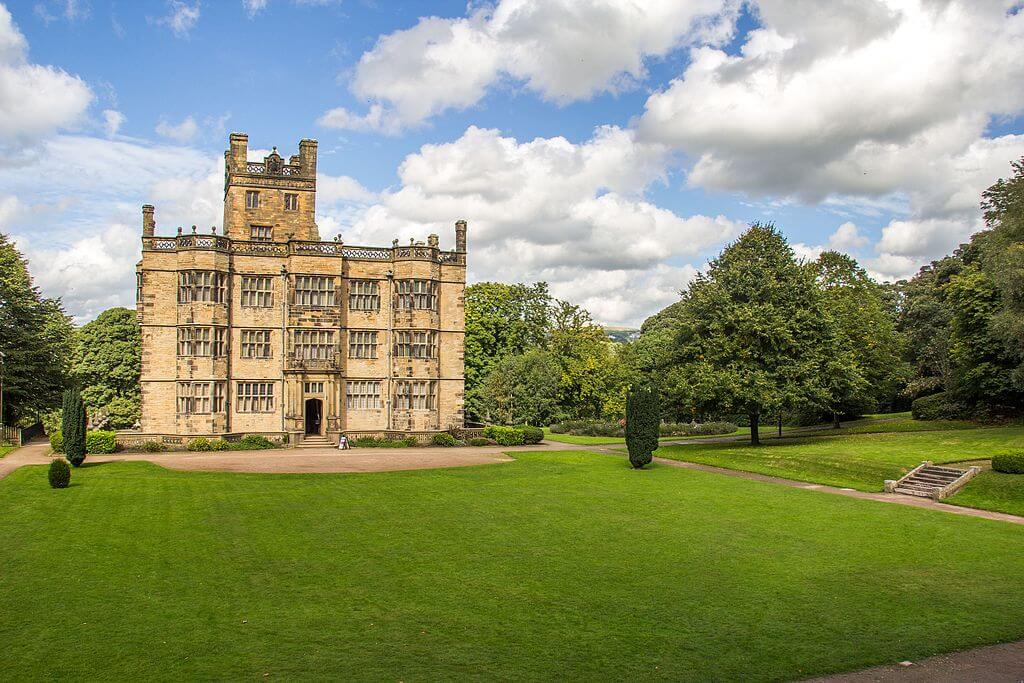
Gawthorpe Hall
The Elizabethan country house Gawthorpe Hall is sometimes referred to as the “Downton of the North”. Architect Sir Charles Barry, who designed Highclere Castle in Hampshire which is the film location of the popular television series Downton Abbey, also designed Gawthorpe Hall.
The house shows the Gawthorpe Textile Collection, a collection of intricate needlework, lace, and costumes collected by Rachel Kay Shuttleworth. And the house also displays a collection of contemporary pieces from regional artists.
Gawthorpe Hall is also one of the trailheads of the Brontë Way. This is a long-distance footpath that links places that have a strong connection with the writings of the Brontë family.
The Hall is owned by the National Trust and is open to visitors. Visit the website for opening times.
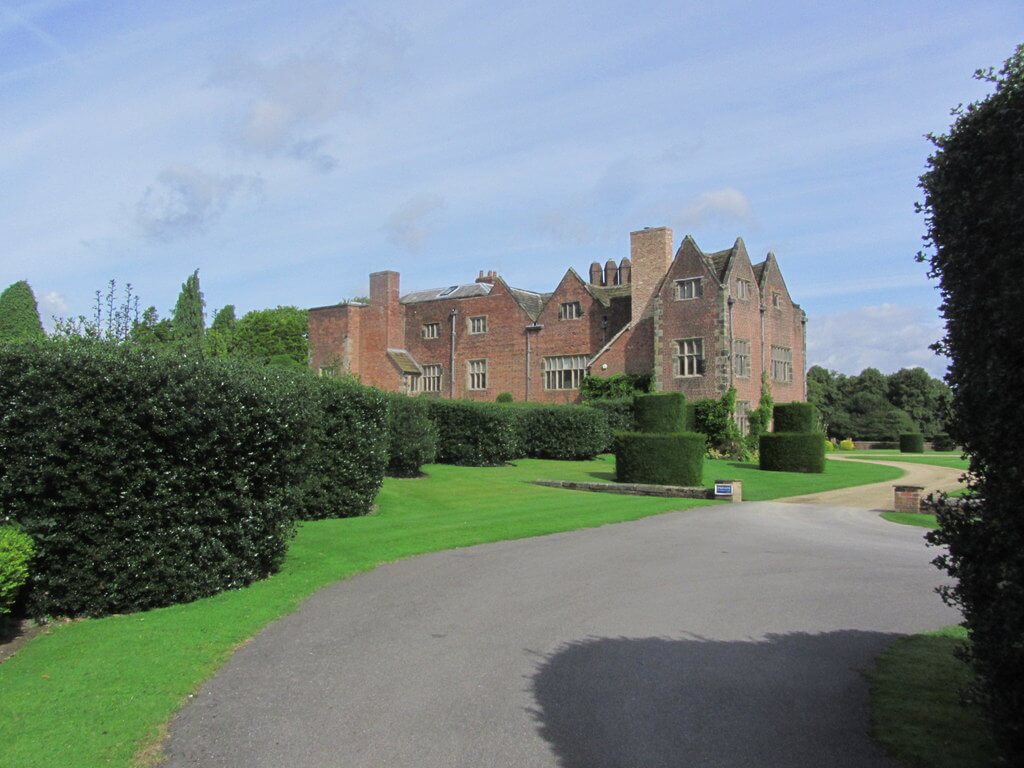
Peover Hall
Peover Hall is an Elizabethan country house that was built for Sir Randle Mainwaring. 500 years later, the house is still used as a family home. The house has a rich interior with oak paneling, a long gallery, and furniture with a connection to the house and the Mainwarings that have been acquired through country house sales.
The house has been renovated since the Second World War when it was badly damaged after a US soldier started a fire. At that time, the house was used as the HQ for General George Patton of the United States 3rd Army to train for the D-Day landings.
The house and grounds are open to visitors. Visit the website for opening times.
Elizabethan Houses in the Midlands

Hardwick Hall
Hardwick Hall is one of the best examples of an Elizabethan prodigy house and one of the earliest examples of the Renaissance style in England. The house was built for Bess of Hardwick, who was the richest woman in Great Britain after Queen Elizabeth I, and the keeper of Mary, Queen of Scots.
The house was revolutionary for its many large windows, which was a clear sign of wealth at that time. The symmetrical floor plan was also new in a residential building. The Great Hall of Hardwick is built on an axis through the center of the home and the ceiling height of the floors increases the higher you go.
For centuries, the house was owned by the aristocratic Devonshire family (Bess had been married to Sir William Cavendish, the family name of the Dukes of Devonshire). But now the home is owned by the National Trust. Besides the ground-breaking architecture, you can also view a large collection of 16th century textiles (including works by Bess of Hardwick) and a large collection of fine tapestry and furniture from the 16th and 17th centuries. Visit the website for opening times.

Doddington Hall
Doddington Hall is one of the houses that was designed by one of England’s finest Elizabethan architects, Robert Smythson. This late Elizabethan manor house is still a much-loved family home (it’s currently owned by Claire and James Birch) and features an amazing collection of furniture, weaponry, paintings, ceramics, textiles, and porcelain as well as a great collection of stories.
Famous are the Doddington tapestries that featured in the Holly Bedroom and the Yellow Bedroom. Sir John Hussey Delaval covered these rooms with tapestries showing “Scenes from Rural Life”. The tapestries were made in Flanders in the early 17th century.
The house is surrounded by six acres of walled and wild gardens. The house and grounds are open to visitors. Visit the website for opening times.

Wollaton Hall
Standing on a hill in Wollaton Park in Nottingham stands the Elizabethan country house Wollaton Hall. The prodigy house was built by Sir Francis Willoughby and is designed by Robert Smythson. The house stayed in the Willoughby family until the 19th century.
Wollaton Hall is now home to the Nottingham Natural History Museum and the Nottingham Industrial Museum. Visit the website for opening times.
Morville Hall
Morville Hall is an Elizabethan house that after renovations around, 1750 now looks like a Georgian country house. However, inside you can still see Elizabethan features and outside lie Elizabethan topiary gardens as well as Italian gardens. Each section of the garden relates to a previous occupant of the house. The house is owned by the National Trust and it’s open to visitors.

Shipton Hall
Shipton Hall is an Elizabethan manor house with views of the Shropshire Hills. The house was built in 1587 by Richard Lutwyche to replace an older timber house. In the mid-18th century, the house was largely rebuilt in Georgian style with Rococo interiors though you can also see elements of Elizabethan paneling and timberwork. The house features beautiful plasterwork, chimneypieces, and wood paneling. The house is open to visitors though guided tours. Visit the website for more information.

Harvington Hall
Harvington Hall is a moated country house in Worcestershire that shows a combination of medieval and Elizabethan architectural styles. The medieval house was transformed in 1578 by Humphrey Pakington into the manor house we see today. The house however was considerably larger than we see today, two wings were destroyed in around 1700.
Humphrey Pakington was Catholic and refused to attend Church of England services after the Reformation. It was illegal for Catholic priests to set foot in England and during these times several country houses had “priest holes” to protect Catholic priests or followers. Harvington Hall has seven priest hides which are more than any other house in England. The house also features rare Elizabethan wall paintings.
The house is open to visitors. Visit the website for opening times.

Kirby Hall
Kirby Hall is one of the earliest examples of an Elizabethan prodigy house. The house was built for Sir Christopher Hatton, Lord Chancellor to Queen Elizabeth I, using inspiration from French architecture. Over the centuries, classical elements have also been added to the house.
The house is now semi-ruined with some rooms roofless but the Great Hall and the staterooms are intact. A visit to Kirby Hall will take you back to Jacobean times when the hall was in its heyday. During these times King James I and his wife Anne of Denmark were frequent visitors. The Great Hall is restored to its original color palette and in the Great Chamber you can participate in interactive games.
The house is owned by the Earl of Winchilsea but it is managed by English Heritage and open to visitors. Visit the website for opening times.
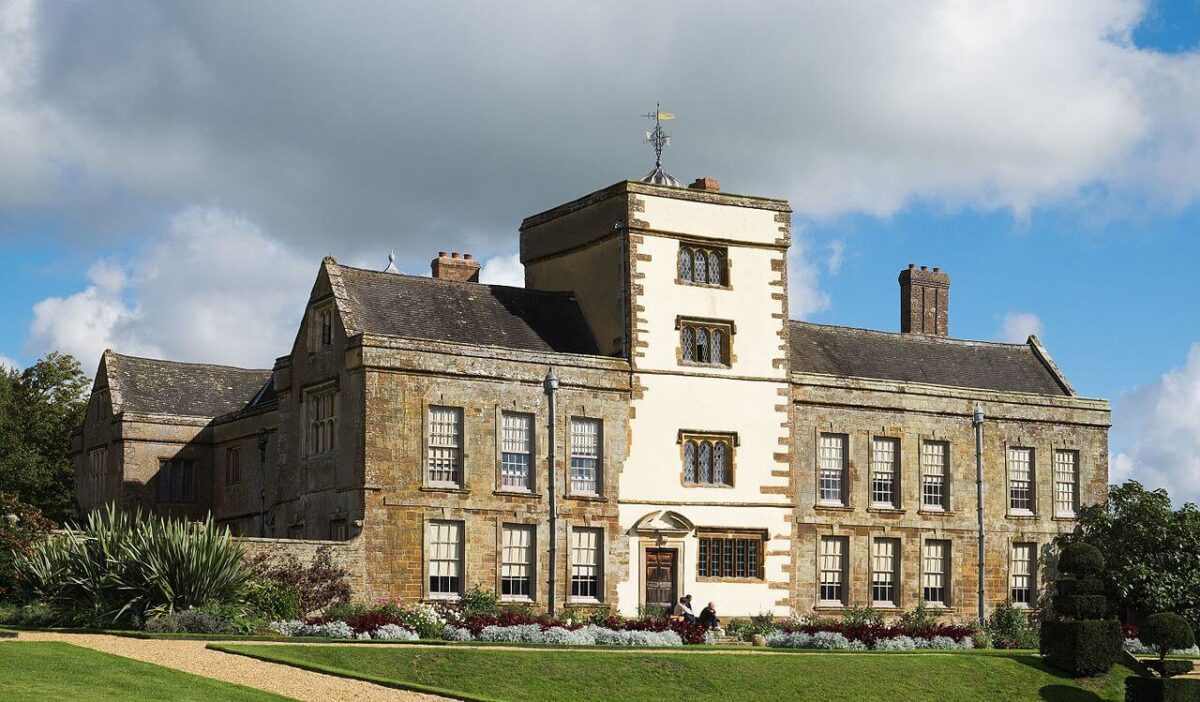
Canons Ashby House
Canons Ashby House is an Elizabethan manor house in Northamptonshire. The house was built by the Dryden family using the remains of a medieval priory. The house is largely unchanged since 1710 and features Elizabethan wall paintings and Jacobean plasterwork. The house is owned by the National Trust who present it as it was during the Victorian era. Visit the website for opening times.

Kinnersley Castle
The Elizabethan manor house, Kinnersley Castle, is a family-owned historic house in Herefordshire. The name castle comes from the Norman castle that stood on this site to protect England along the border with Wales. The house has a solar room featuring some of the oldest intricate plasterwork ceilings in Herefordshire. Eight acres of grounds surround the house with yew hedges, an orchard, a big cedar tree, a kitchen garden, and one of the largest ginkgo Biloba trees in the country.
The houses is open for guided tours on selected days. Visit the website for more information.
Elizabethan Houses in Southern England

Montacute House
Montacute House is one of the few Elizabethan prodigy houses that has been left largely unchanged since its construction. The architectural style of the late Elizabethan house shows the development from medieval Gothic to Renaissance classical style.
The house features the longest “Long Gallery” in England. Here, you can see portraits that are on loan from the National Portrait Gallery. The house, gardens, parkland, and café are open to the public. Visit the website for opening times.
Longford Castle
Longford Castle is an Elizabethan prodigy house that was built by Thomas Gorges and Helena Snakenborg, a Swedish-born noblewoman who was a Lady in waiting to Queen Elizabeth I. The house was built in a triangular shape which is common in Swedish castles. Since 1717, the castle has been owned by the des Bouverie family (the Earls of Radnor).
In the 18th century the castle was transformed into a hexagonal palace after a design by architect James Wyatt. The Fourth Earl of Radnor and Anthony Salvin completed the house. Longford Castle is home to an impressive art collection for which they work together with the National Gallery.
Longford Castle is best known for appearing as the castle in Genovia in The Princess Diaries movie.

Longleat
Longleat is the seat of the Marquesses of Bath and it’s a beautiful example of an Elizabethan prodigy house. The house has been owned by the Thynn family since they acquired the title Marquess of Bath in 1789.
The stately home was the first to open its doors to the public. You can visit fifteen rooms showing 450 years of Longleat history. From the Great Hall with large paintings to the library with more than 40.000 volumes.
Besides being a stately home that is open to the public, the grounds of Longleat is are also home to a safari park, the first dive through Safari Park outside Africa, and home to more than 500 animals.

The Red Lodge
The Red Lodge is an Elizabethan house in Bristol. The house was built by Sir John Young who was a courtier to Henry VIII and Elizabeth I. At that time it was used as a guest house and a place for entertainment. Young and his guest could promenade through eight ornamental gardens and orchards to wine and dine them.
The house was doubled in size during the Georgian period but the Great Oak Room, the Small Oak Room, and the Bedroom were left in their original Elizabethan style. The Red Lodge is currently open to visitors as a historic house museum. Here, you can see beautiful Tudor rooms, an original portrait of Elizabeth I, and original furniture. Outside you can wander through an Elizabethan knot garden. Visit the website for opening times.
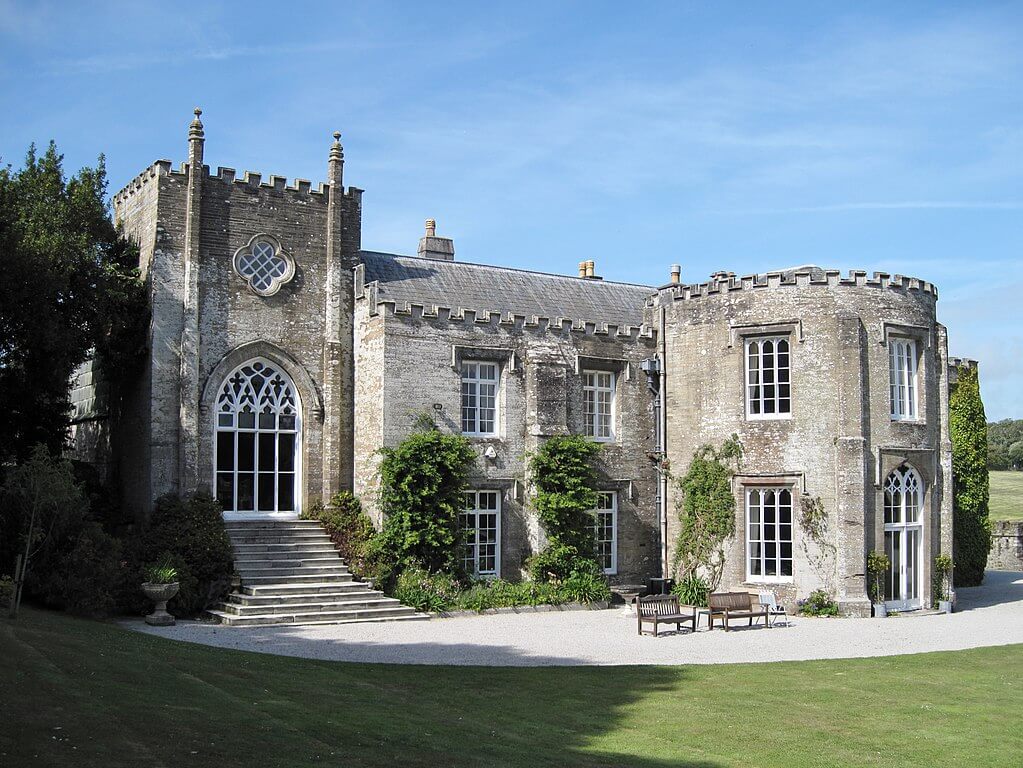
Prideaux Place
Home of the Prideaux family for four hundred years, this Elizabethan country house in Cornwall also features neo-Gothic elements. The house is home to a great collection of art, including royal and family portraits, furniture, and the Prideaux Porcelain Collection. In the Great Chamber the original ceiling has been uncovered that shows beautiful Elizabethan plaster work.
The house has a strong connection to the television and book series Poldark. Not only is the house used as a film location for the BBC series, but Winston Graham (the author of the books) visited this Elizabethan country house many times. The last Poldark novel “Bella Poldark” was partly written at Prideaux Place and the house is also mentioned in the novels.
Guided tours of the house are available. Visit the website for more information.

Trerice House
Trerice House is an Elizabethan manor house in Cornwall. The house was built by John Arundell in 1572, the Arundell family owned this site from the 14th century to 1768. The manor house was often left alone by its owners and therefore you can still find beautiful Elizabethan features such as the decorative plasterwork in the Great Hall.
The house, with its fine interiors, and peaceful gardens are now owned by the National Trust and open to the public. Visit the website for opening times.

Englefield House
Englefield House is a large Elizabethan country house and estate in Berkshire. The house was built around 1558 but it was greatly remodeled in the 1820s. In the 17th century, the house was purchased by John Paulet, 5th Marquess of Winchester who became famous in the Civil War for defending Basing House.
Currently, Englefield House is still owned by descendants of John Paulet (currently the Benyon family). The house is still privately owned but it can be rented for as an exclusive venue. Pippa Middleton, the sister of Catherine, Princess of Wales, was married at the church at the Englefield Estate with the reception being held at Englefield House. The house also features in television series and films such as The Crown, Cruella, X-Men, and The King’s Speech.
The gardens at Englefield House are open to visitors. They were created in the 1860s and feature a great variety in flowers and plants as well as a walled kitchen garden and a grotto. Visit the website for more information.
Glynde Place
In the South Downs National Park with views over the Weald and Sussex Downs stands the Elizabethan manor house Glynde Place. Since its construction in 1569, the house has been owned by the Viscounts Hampden.
The house is open for guided tours in May and June. And the house is also the host of a series of concerts. Visit the website for more information.

Chavenage House
Chavenage House is an Elizabethan manor house that is built in the typical E shape floor plan. The house is built of Cotswolds stone and the glass for the windows was obtained from redundant churches and monasteries.
The house is often used as a filming location, most notably for appearing as Trenwith in the BBC series Poldark. The house is still a family home, but the Elizabethan manor can be visited on specific days. Visit the website for more information.
Eastbury Manor House
Eastbury Manor House is an Elizabethan manor house in Greater London. The house was built by Clement Sisley, a wealthy merchant. The exterior of the house is still Elizabethan but indoors, the rooms were demolished and changed in later centuries. The house was in bad shape when the National Trust bought it in 1918 but since then it has been restored and is now a historic house museum with special exhibitions set in tranquil Tudor-inspired gardens. Visit the website for opening times.

Breamore House
Breamore House is an Elizabethan manor house in Hampshire. The house was built by the Dodington family in 1583 on the site of Breamore Priory. In the 18th century, the house was purchased by Sir Edward Hulse M.D., the physician of Queen Anne, King George I, and King George II. The Hulse family still own the house to this day.
A house tour shows what life was like in the 18th century. You will view the staterooms, living quarters, social spaces, and functional rooms. The estate also houses a post-war village museum. Visit the website for opening times.

Chawton House
Chawton House is an Elizabethan manor house in Hampshire. The house is best known for being the home of Edward Austen Knight, the brother of Jane Austen. Jane also visited the house, and according to the Knight family legend the liked to sit the in reading alcove of the Oak Room.
The Chawton library is now the Centre for the Study of Early Women’s Writing, 1600–1830. The house shows portraits and items belonging to the Knight family as well as a collection of women’s writing. Visit the website for more information.

Mapledurham House
Mapledurham House is an Elizabethan stately home in Oxfordshire. The house is designed in a classical E shape and was built around 1585 by Sir Michael Blount. Mapledurham House is to this day owned by the Blount-Eyston family.
The house was often visited by the poet Alexander Pope as he was enamored of two daughters who lived at the house. Queen Anne of Denmark also stayed at the house in the early 17th century.
The house is currently closed to visitors as the owners will carry out an extensive programme of repairs. Visit the website for more information and to learn more about potential new opening times.





